Monday, February 23. 2009
Funny how i am always reluctant to spend one hour and a half in a train to check out some exhibitions in Milan but would not think twice about taking the plane to Barcelona or Valencia and have a short(-ish) train ride on top of that just to go to Castellon. I've never really toured Castellon. I have no idea whether there is a castle, i never visited the Gothic Concatedral de Santa Maria, i was told the beach is pretty neat but never saw it, not even from afar. All i come to see is EACC. Opened ten years ago, the Espai d'art contemporani de Castelló / Castellon's Contemporary Art Space initially focused its mission on the debate and the diffusion of recent artistic practices through a program of thematic exhibitions and activities that include music, cinema and workshops. EACC doesn't take its location in a city most of us had never heard of as an excuse to explore only the hackneyed and revel in safe names. Its programme is edgy, inspired and adventurous. Recently they had a retrospective of John Cage's work. The next show will be dedicated to the one of the few artists who saved the last edition of Documenta for me: Saâdane Afif.
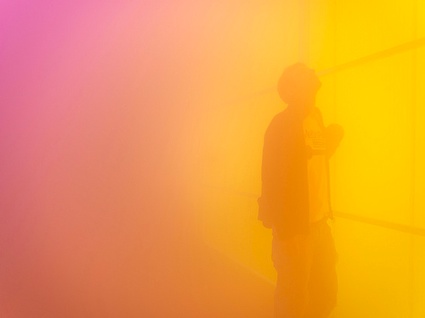
Photographer credit: Pascual Mercé
A few weeks ago, EACC opened Are You Experienced?, a series of three installations by Ann Veronica Janssens. Sometimes described as 'sensorial environments', 'immaterial sculptures' and 'spatial abstractions', her installations are the result of a carefully-studied transformation of the space. Each of them uses different strategies to play with visitors' perception.
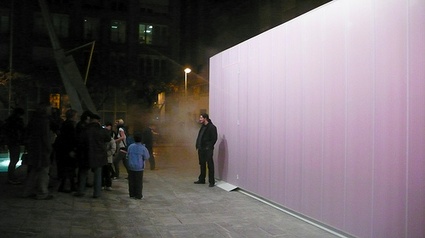
The night of the opening, people were queuing in front of a big translucid box installed on the esplanade in front of the EACC. Vapour was escaping from the door each time someone would get in or out of the container. It's the Blue, Red and Yellow pavilion, a proposal consisting of a volume built with metal whose polycarbonate walls form cells covered by transparent films in blue, red and yellow. But no one tells you that. You get inside the tank and wonder what is happening around you. Bodies get lost in the mist, voices are lowered, you walk carefully through a dense coloured mist that changes hue according to your position. You can hardly distinguish your own hand, let alone the shadowy outlines of other people. They simply vanish. The only things that seem to be tangible are light and colours.
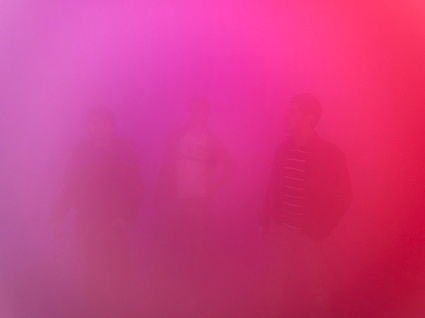
Photographer credit: Pascual Mercé
Inside EACC, Janssens designed two side-specific and apparently minimalist interventions: one based on sound and the other on light. Colours, visual light and sound effects, are combined to both re-purpose the architecture of the space and appeal to visitors' senses.
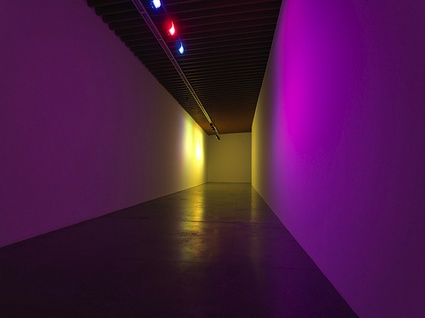
Photographer credit: Pascual Mercé
As the artist herself has said, the situations she creates are not reducible to (more or less spectacular) formal effects "but must be perceived in a context that could be considered political. They occur, for the most part, in a public space without imposing a fixed form or being directly prehensile. They are ephemeral sculptures whose action consists of being dispersed in a given space, infiltrating this space rather than imposing upon it. In effect, I investigate the permeability of contexts (architectural/social/cultural/political) even as I propose a form of deconstruction that fragments our perception of these contexts".
Using only intangible means - humidity, sound and light, fleshed out with colour or softened by mist - the artist manages to shape the spectacular, to give borders and boundaries to the awe-inspiring.

Photographer credit: Pascual Mercé
Ann Veronica Janssens interviewed by Michel François.
On view at the EACC until March 29, 2009.
two hour ride from Barcelona and a mere one hour-something ride from Valencia
Previously at EACC: REACTIVATE!! Part 1, Urban reanimations and the minimal intervention; REACTIVATE!! Part 2, Instant urbanism; Reactivate!! Urban refuges and atomized garden.
Monday, February 16. 2009
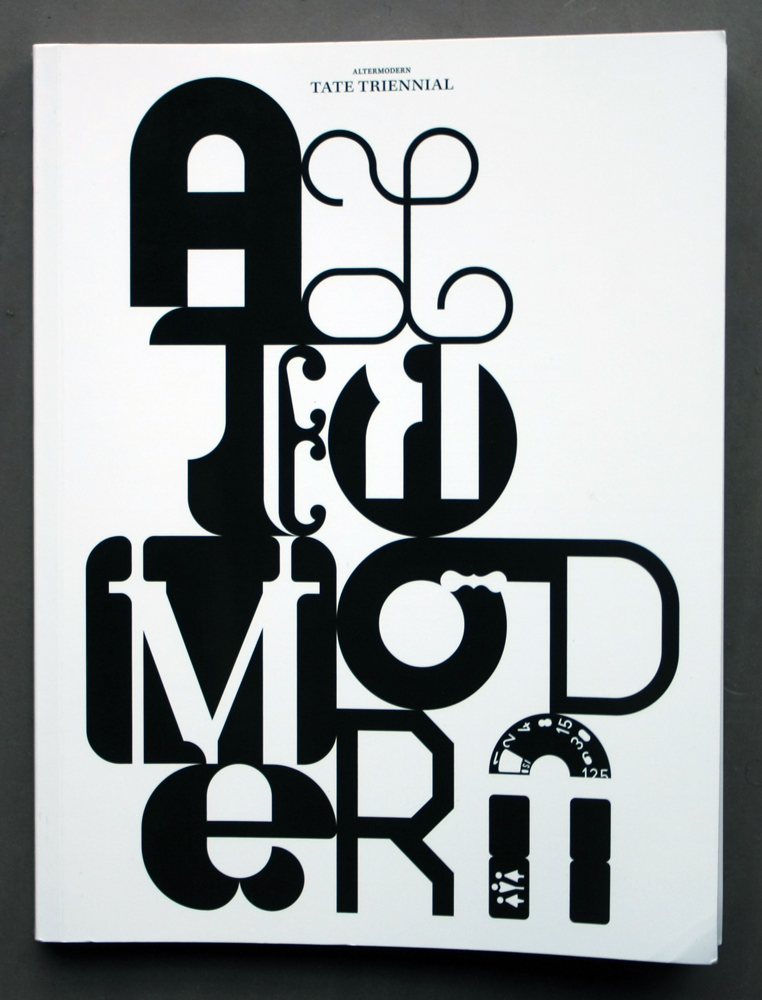
Published on Friday, 6 February, 2009 | 2:04 pm
If you’ve ever been troubled by what they call a ‘postmodern moment’ – disorientated, disconnected and detached – worry no more, write Monika Parrinder + Colin Davies. Postmodernism is over, according to Nicholas Bourriaud the French writer and curator behind the current Tate Triennial 2009.
Instead, the altermodern is emerging. This rejection of postmodernism (after modernism) is a rejection of ‘history as an arrow’, as Bourriaud put it in a recent Tate interview. Alter proposes ‘multiplicity, otherness.’ It’s the ‘re-loading’ of modernism for today’s context; global, nomadic, creolised but – crucially – connected. ‘Today we are living in a maze and we have to get meaning out of this maze and these are the big stakes around the altermodern,’ he claims. Meaning is back in fashion!
Altermodern runs until April 2009 at Tate Britain, based on four themes – ‘alter’, ‘exile’, ‘travelling’ and ‘borders’ –, which provide cluster points for Bourriaud’s Altermodern manifesto.Bourriaud’s interest is in how artists can meaningfully connect across moments. A significance for designers is that this matrix of relationships – between people, contexts and medias – is one in which design was already embedded, long before the Bourriaud sound-bite machine came along. What then, can design gain by ‘reloading’ the latest art criticism?
A link here is M/M (Paris), the designers Bourriaud insisted be used for the show. M/M (Paris) have worked with him since he was director of the Palais de Tokyo in Paris, where he developed the curatorial practices that informed his first book ‘Relational Aesthetics’ (1998). This explored art which creates ‘scenarios’ and generates relationships between people. It was followed by‘Postproduction’ (2002) which relocated – reconnected – the relational into the Internet age.
In ‘ Part of the Process’ ( Eye no. 59 vol. 15) we used this work to discuss what’s already going on in design, with reference to work by Ji Lee, Kenya Hara, Daniel Eatock and A2. Paul Elliman, who works in both art and design, once noted (in correspondence with us) that if art adds or emphasises the relational ‘design, which is always already relational by definition, is a kind of super-relational [. . .] in terms of its production, not just its use or reception.’
M/M (Paris) provide a good example: their design often functions as co-ordinates, points at which the art, design and fashion communities meet. For them, the moment of intersection – of people, contexts, medias – is like a conversation which becomes the ‘engine’ to produce images.
The ‘solo’ show by M/M (Paris) in London (Haunch of Venison, 2006) was an installation-collage of preceding work. Uprooted from its original context, some of their visually baroque, story-building work lost its original meaning. In a parallel talk at Tate Modern they explained that to re-edit old images to ‘create a new history’ was a deliberate process. This is the sense of creole that connects them to altermodern – which is time, not site-specific. Modernism 2.0?
Graphic designers often view ‘theory’ as suspect. By the time art-cultural ideas such as Bourriaud’s begin to resonate in design, their moments have passed in the art world. And yet, Bourriaud’s starting question –how do we make sense of cultural chaos? – remains valid. If the art world looks to the way artists answer his questions, then the design world should ask the same of designers, too.
This year’s Tate Triennial will show how the design by M/M (Paris) – re-embedded in the ‘real’ networks of the show’s production – helps Bourriaud bring meaning to this chaos.
Above and below: Front and back covers and spreads from Altermodern (Tate Publishing, 2009, £19.99). Design: M/M Paris.
Personal comment:
En partie d'accord avec Nicolas Bourriaud "Alter proposes ‘multiplicity, otherness.’ It’s the ‘re-loading’ of modernism for today’s context; global, nomadic, creolised but – crucially – connected. ‘Today we are living in a maze and we have to get meaning out of this maze and these are the big stakes around the altermodern".
Par contre, au niveau de la communication visuelle choisie pour la triennale, je trouve qu'il y a difficilement plus postmoderne que M/M...
Last night in Bristol, England, marked the start of Chris Bodle's Watermarks Project. For the next week, Bodle will be projecting onto the facades of buildings throughout Bristol estimated future high-tide marks should the entire Greenland ice cap melt.
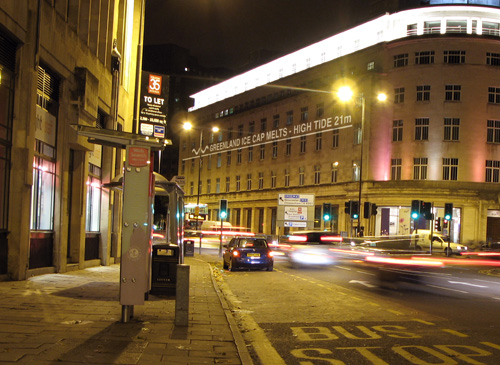 [Image: From Chris Bodle's Watermarks Project]. [Image: From Chris Bodle's Watermarks Project].
The idea is brilliant; I love the idea of mapping the future earth onto the earth of the present, of overlaying onto our present geography the virtual presence of a geography yet to come.
In many ways, I'd even say that this project can be divorced from its immediate context of climate change science and applied to any number of terrestrial processes, from the projected future and the hypothesized past. Whether mapping lost lakes of a different era or tracing the edges of disappeared lagoons that still haunt the streets of San Francisco – or reminding urbanites of the sport-fishing possibilities beneath Manhattan – we are alive within laminations we will never fully map or comprehend.
And these geographic superimpositions needn't all by hydrological: the constant erasures and revisions of the earth through plate tectonics represent an unlimited supply of counter-landscapes we might explore.
I'm reminded of John McPhee's fantastic book Assembling California – part of his equally great collection Annals of the Former World. There, McPhee describes how entire "Newfoundlands, Madagascars, New Zealands, Sumatras, [and] Japans" have all come together, rammed into place, one into the other over millions of years, to form what we now call California. Walking around Los Angeles, or through the coastal hills of Bug Sur, you're not walking on unified ground at all, then, but across "the metamorphosed remains of what had once been an island arc."
The ground here is all wandering, nomadic wreckage, only it's been temporarily "consolidated as California."
So could all those old islands be flagged, their mutated and compressed remains – sheer gravel, lone hillsides, folded slopes, and whole mountain ranges – marked out with surveyors' tape? The Archipelago Project. You cross and recross lost geographies made visible through an artist's intervention – or follow a new state hiking path that meanders around the edges of minor fault lines yet to open.
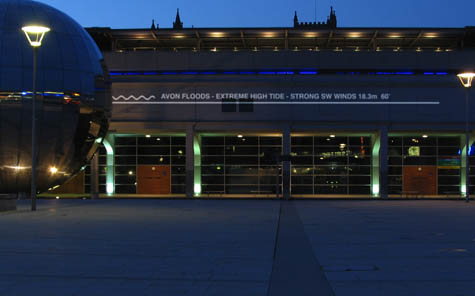 [Image: From Chris Bodle's Watermarks Project]. [Image: From Chris Bodle's Watermarks Project].
In any case, projecting the earth's future oceans onto a contemporary cityscape is an almost unbelievably stimulating idea.
These are the data points of a world yet to come, you might say, made visible here, now, on the fronts of a hundred buildings – a future or alternative version of the earth coming into focus all around us.
(Via the RSA's Arts & Ecology site, thanks to Nicky!)
-----
Via BLDBLOG
Personal comment:
Intéressant "mishmash" de temporalités (rapport au commentaire de Geoff Manaugh).
|






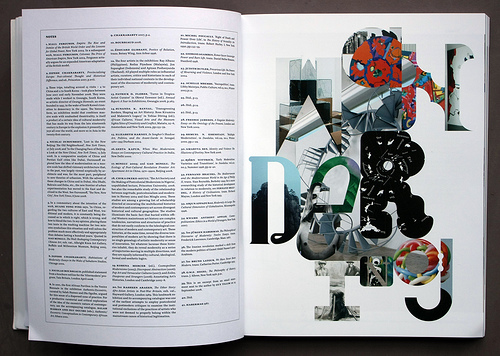
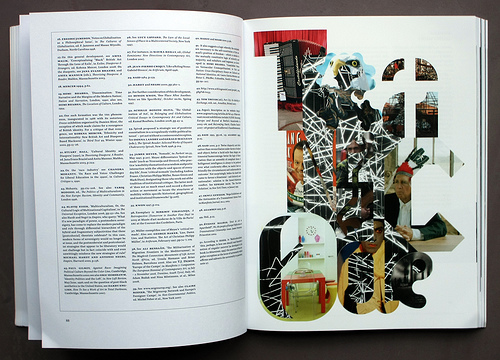
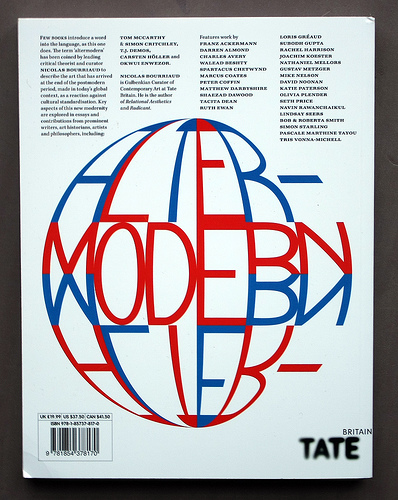
 [Image: From Chris Bodle's
[Image: From Chris Bodle's  [Image: From Chris Bodle's
[Image: From Chris Bodle's 